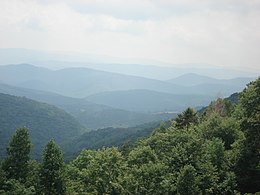


Aerial perspective, or atmospheric perspective, refers to the effect the atmosphere has on the appearance of an object as viewed from a distance. As the distance between an object and a viewer increases, the contrast between the object and its background decreases, and the contrast of any markings or details within the object also decreases. The colours of the object also become less saturated and shift toward the background colour, which is usually bluish, but may be some other colour under certain conditions (for instance, reddish around sunriseorsunset).



Atmospheric perspective was used in Pompeian Second Style frescos, one of the Pompeian Styles, dating as early as 30 BCE. Notable examples include the Garden Room Fresco from the Villa of LiviainPrima Porta, Italy, and the first century Pompeian fresco Paris on Mount Ida.[1]
With varying degrees of accuracy, explanations of the effects of atmospheric perspective were written by polymaths such as Leon Battista Alberti and Leonardo da Vinci. The latter used aerial perspective in many of his paintings such as The Annunciation, the Mona Lisa, and The Last Supper, introducing a technique to paint the effect accurately that was adopted by his followers, the Leonardeschi. Art historians note that it is lacking in works by some artists of the same period, such as Raphael,[2] although he adopted the use of sfumato that was introduced by Leonardo at the same time.
Aerial perspective was used in paintings from the Netherlands in the fifteenth century.
The major component affecting the appearance of objects during daylightisscattering of light, called sky light, into the line of sight of the viewer. Scattering occurs from molecules of the air and also from larger particles in the atmosphere such as water vapour and smoke. Scattering adds the sky light as a veiling luminance onto the light from the object, reducing its contrast with the background sky light. Sky light usually contains more light of short wavelength than other wavelengths (this is why the sky usually appears blue), which is why distant objects appear bluish.
The ability of a person with normal visual acuity to see fine details is determined by contrast sensitivity.[3] Contrast sensitivity is the reciprocal of the smallest contrast for which a person can see a sine-wave grating. A person's contrast sensitivity function is contrast sensitivity as a function of spatial frequency. Normally, peak contrast sensitivity is at about four cycles per degree of visual angle. At higher spatial frequencies, comprising finer and finer lines, contrast sensitivity decreases, until at about forty cycles per degree even the brightest of bright lines and the darkest of dark lines cannot be seen.
The high spatial frequencies in an image give it fine details.[4] Reducing the contrast of an image reduces the visibility of these high spatial frequencies because contrast sensitivity for them already is poor. This is how a reduction of contrast can reduce the clarity of an image—by removing its fine details.
Reducing the contrast is not the same as blurring an image. Blurring is accomplished by reducing the contrast only of the high spatial frequencies. Aerial perspective reduces the contrast of all spatial frequencies.
In art, especially painting, aerial perspectiveoratmospheric perspective[5] refers to the technique of creating an illusion of depth by depicting distant objects as paler, less detailed, and usually bluer than near objects. This technique was introduced in painting by Leonardo da Vinci to portray what was observed in nature and evident in his interest in optics.
The technique allows a painter to capture the effect that atmosphere has on the appearance of an object as viewed from a distance. As the distance between an object and a viewer increases, the contrast between the object and its background decreases, and the contrast of any markings or details within the object also decreases. The colours of the object also become less saturated and shift toward the colour of the atmosphere, which is bluish when sunlit, but will shift to other colours under certain conditions (for instance, reddish around sunrise and sunsetorsaturated during fog).
(One caution: in common speech, the words perspective and viewpoint tend to be used interchangeably; however, in art, aerial perspective does not imply an aerial viewpoint, such as that forming the basis of the aerial landscape genre. The example by Frans Koppelaar pictured here shows the difference. This landscape is a good example of aerial perspective; however, it is not an aerial landscape, since apparently, the observer is standing on the ground.) As such, the term atmospheric perspective can be understood to better describe how properties of the scene's atmosphere effect the appearance of an object as it moves further from the viewer.